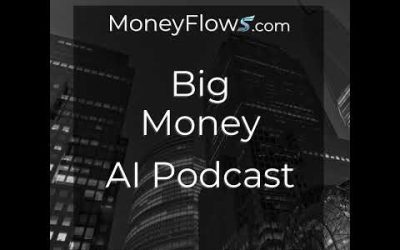by Bryan Perry
August 20, 2024
As the stock market enjoyed a “V-shaped” rebound in the span of two weeks, erasing the losses from the trap door sell-off of August 2-5, we have also seen some other key developments worth noting – in fact, some that don’t really jibe with the 9-day run-up in the stock averages. Typically, when the stock market celebrates tame inflation data (in the CPI and PPI), coupled with a rosy monthly retail sales rise, there tends to be a “risk off” reaction in defensive assets, giving way to newfound “risk on” sentiment.
Graphs are for illustrative and discussion purposes only. Please read important disclosures at the end of this commentary.
With most of the second-quarter earnings season in the record books, FactSet reported that the blended (year-over-year) earnings growth rate for the S&P 500 is 10.9%. If 10.9% is the actual growth rate for the quarter, it will mark the highest year-over-year earnings growth rate since Q4 2021 (31.4%), offsetting the fear that created the heightened level of uncertainty that fueled the market collapse earlier this month.
In support of those second-quarter numbers – which are admittedly backward looking – and the receding chatter about the risk of an economic slowdown that could be coming, it should be noted that FactSet also measured just how concerned America’s top companies feel about a potential recession or ‘hard landing.’ In the conference call transcripts of all the S&P 500 companies that conducted earnings conference calls from June 15 through August 15, FactSet Document Search (which allows users to search for key words or phrases across multiple document types) was used to answer this question about recession warnings.
Among these companies, only 28 cited the term “recession” during their second-quarter earnings calls – a number well below the 5-year average of 83 and the 10-year average of 60. In fact, the 28 citations in the second quarter is the second-lowest number of S&P 500 companies citing “recession” on earnings calls since Q4 2021 (15). Once again, this kind of earnings call data is, of and by itself, highly reassuring.
Graphs are for illustrative and discussion purposes only. Please read important disclosures at the end of this commentary.
Apparently, the abysmal August 2 employment report (114,000 non-farm payroll jobs versus 170,000 forecast, and 4.3% unemployment rate versus 4.1% forecast) is no longer a serious concern. The weekly jobless claims data that followed came in line, per consensus forecast. The next set of jobs data is set for August, due out Friday, September 6. So, there is not much to worry about until then, it would seem.
The Japanese yen carry trade has been reported to be unwound – to what extent is largely unknown, but the market is of the view that it is – yet even as the yen has retreated during the past nine trading days that have also seen stocks rebound, the chart of the U.S. Dollar Index (DXY) tells a different story. A feeble attempt to rally off the August 5th low has failed, and now it appears as if the greenback is rolling over.
First the yen chart:
Graphs are for illustrative and discussion purposes only. Please read important disclosures at the end of this commentary.
And now, the Dollar index:
Graphs are for illustrative and discussion purposes only. Please read important disclosures at the end of this commentary.
To be fair, a 20-year chart of the U.S. Dollar index has a healthier looking long-term chart. The 20-year chart (below) shows that the dollar has fared well. It’s just that the uptrend is tainted by the protracted deterioration of the euro, yen and other currencies in DXY. Only the Swiss franc (FXF) has done better.
Graphs are for illustrative and discussion purposes only. Please read important disclosures at the end of this commentary.
Does this mean the dollar is merely “the least dirty” major currency in the global basket of currencies that dominate trade outside China? It’s not meant to be, but rather general currency weakness might explain why the price of gold is trading at new all-time highs. As of last Friday, the price of gold closed at $2,538 and experiencing an upside breakout that is taking into account a number of risk factors.
Graphs are for illustrative and discussion purposes only. Please read important disclosures at the end of this commentary.
Central banks are the biggest buyers of gold in recent years. Adrian Ash, Bullion-Vault’s director of research, said in a commentary this week, “Central-bank demand for gold has surged in the past five years, swallowing nearly one in every ten ounces produced by the mining sector on official data.”
The total quantity of gold held in central-bank reserves has increased by almost 19% by weight since 2004, and it’s jumped seven-fold — to $2.4 trillion — in U.S. dollar value, led by Russia, China, India, and Turkey, according to Ash. Paul Wong, market strategist at Sprott Asset Management, added that recent gold buying is “at or very close to exhausting the ‘free-floating inventory’ of tradeable gold.”
The quandary here is that if inflation is coming down, Fortune 500 C-Suites are confident there is no recession visible on the horizon, then it stands to reason that the confluence of more Fed rate cuts than currently conceived are coming – or risk of further currency devaluations, or the Middle East is about to morph into a regional war from a northern invasion by Hezbollah into Israel, or there is a lack of resolve to address the spiraling federal deficit – all providing the mix of catalysts for the bullish move in gold.
The stock market’s resilient move back towards the previous highs is most welcome, and yet investors may want to add some gold to their portfolios, given the size and scope of events occurring around the world and at home, as gold is a time-tested hedge that is making a sudden move higher.
The post 8-20-24: A Goldilocks Economy Begets Rising Gold Prices – What Gives? appeared first on Navellier.






